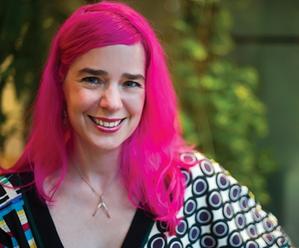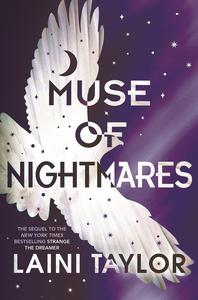
|
|
| photo: Ali Smith | |
Laini Taylor is the New York Times bestselling author of the Printz Honor Book Strange the Dreamer and its sequel, Muse of Nightmares (reviewed below). Taylor is also the author of the Daughter of Smoke & Bone trilogy and the companion novella, Night of Cake & Puppets. Taylor's other works include the Dreamdark books: Blackbringer and Silksinger, and the National Book Award finalist Lips Touch: Three Times. She lives in Portland, Ore., with her husband, illustrator Jim Di Bartolo, and their daughter, Clementine.
Tell our readers about Muse of Nightmares.
Muse of Nightmares is about a lot of things. It's about this character who has had no agency in her life, who has been a prisoner, who is hopeless. It's about seeing the possibility of change. [It's about] beginning to see the humanity of your "enemy," even if you don't want to see it.
There were a couple of things that I knew that I didn't want to do (or do again) when writing this story: I didn't want to have characters that were bad ass, I didn't want to have big action climaxes that involve fighting and I didn't want to have a bad guy. I had written a couple of books in a row where the villains were disgusting, despicable. And I didn't want to go there. I wanted to write a story that was about the aftermath of war and occupation--I wanted to talk about the end of the story.
I think this is my book about forgiveness: whether it's possible to be forgiven and redeemed, to come out of the dark places that happen after war and occupation, to create a new way without becoming a killer yourself and adding to all of the trauma you've already endured.
But it's also a fun story! It's sexy and romantic, and I hope you like it.
You say you didn't really want to include standard bad guys, but the things the dead gods have done are truly horrible. How did you make bad guys without actually making bad guys?
To be clear, really bad guys existed and shaped this world. I didn't want that to be the plot, though. It's about surviving; about trauma survivors and how complicated that is. Like Minya, who endured terrible things as a child... is it possible to break the cycle of vengeance and violence? Or is it just going to go on forever? With Minya, she's a metaphorical embodiment of a trauma survivor. She's even physically frozen in time at the moment that these things happened to her--she doesn't age, she's trapped. And I want to set her free. She's terrible but I think we can all see why she's terrible. There's so little hope in our world of real conflict resolution because we just keep on creating enemies.
 You have said you had the Muse of Nightmares in your head for about 20 years. How did all of the other characters develop?
You have said you had the Muse of Nightmares in your head for about 20 years. How did all of the other characters develop?
I would say that [the Muse of Nightmares, Sarai's,] family came relatively easily. I knew I wanted this group of young people who are the children of gods living in hiding. And it was fun [to create them], like coming up with X-Men. What are their abilities? All of the other characters were more difficult, especially Lazlo. One thing I knew relatively early on was I wanted to enter the world of Weep and the world of Sarai through the eyes of an outsider and that outsider would be my love interest. That was Lazlo's genesis. I kept backing up and backing up to get to what I thought was the beginning of the story. I was getting to know Lazlo and, in the process, he took over. I wrote something like 11 different beginnings involving Lazlo in which he was distinctly different. A lot of details came to me through that process--I would get a piece of him or a piece of the world and then leave all the rest. Then, one day, I wrote the line that his nose was broken by a falling volume of fairy tales and just like that, I knew him. He had literally been transformed by stories. And I loved him so much. The chapter was called "Strange the Dreamer" and that was when he came alive and took the book in a completely different direction. Also, even though I knew who Sarai was, she wasn't fleshed out. For me, main characters are always harder [to discover] because they have to be more nuanced. Secondary characters can be for color and they can be more fun or less complicated.
What do you do to build your magic world?
I've actually been coming up with my magic system for my next world and it's really fun. I can't believe I get to do this for a job! I can't remember how it evolved that this mineral, this metal from probably another world... that there is something in the blood or body of people from that world that interacts with this metal to create magic. I like the idea of each person manifesting a different gift.
Do your works up to this point overlap or intersect?
By the time [readers] get to Muse of Nightmares, [they'll] see the connections clearly, I think. I'm excited for readers of Smoke and Bone. I wanted to do something that could totally stand apart but in which readers could find connections; that could lay the groundwork for potential furthering of joint stories. I think you can gather in Strange, if you're looking, that there are some common elements. You can maybe form a hypothesis for why that is. But in Muse it becomes much clearer. --Siân Gaetano, children's and YA editor, Shelf Awareness

